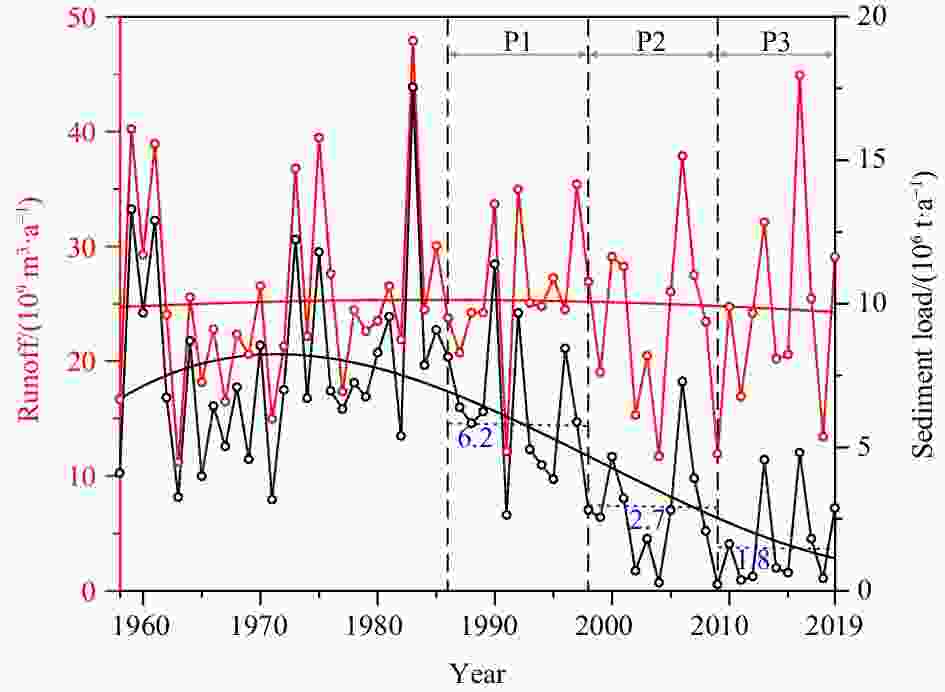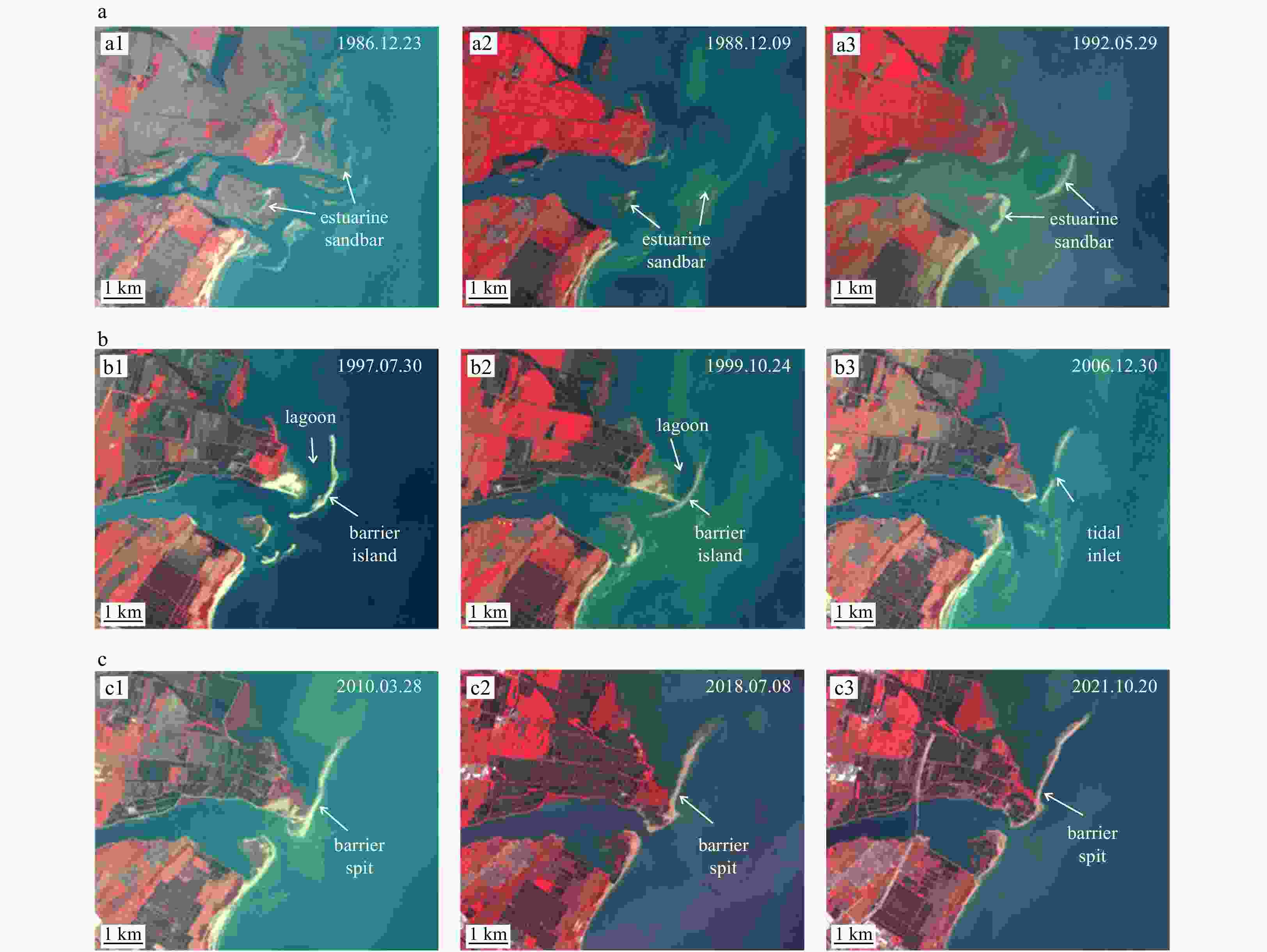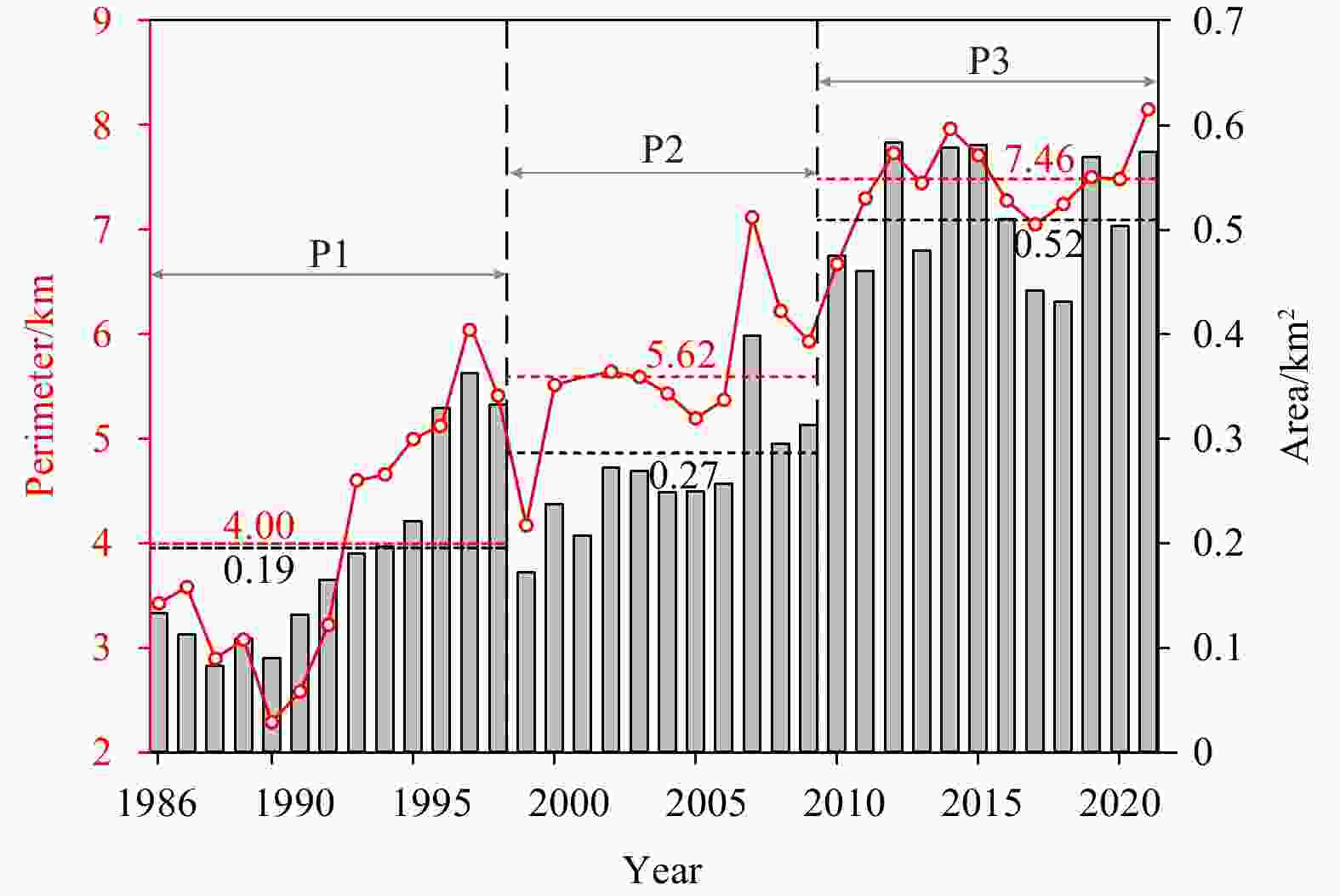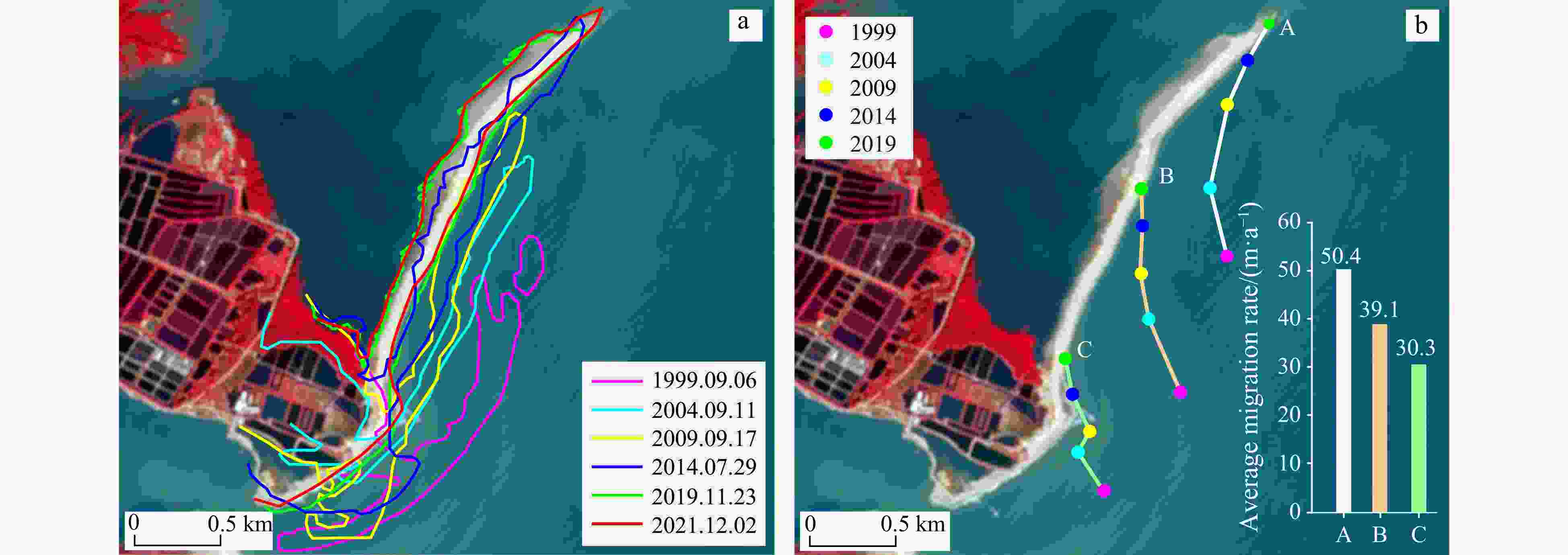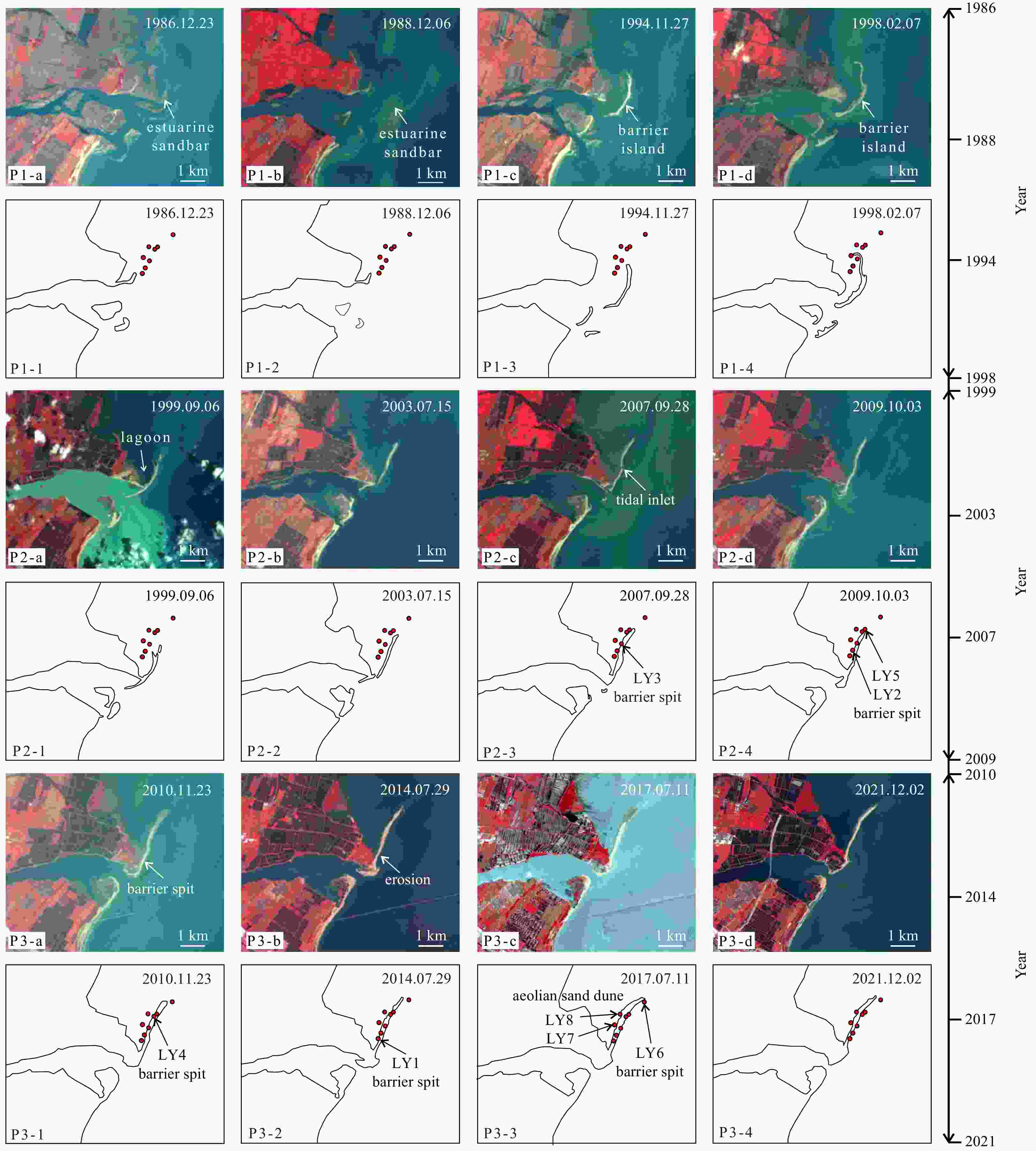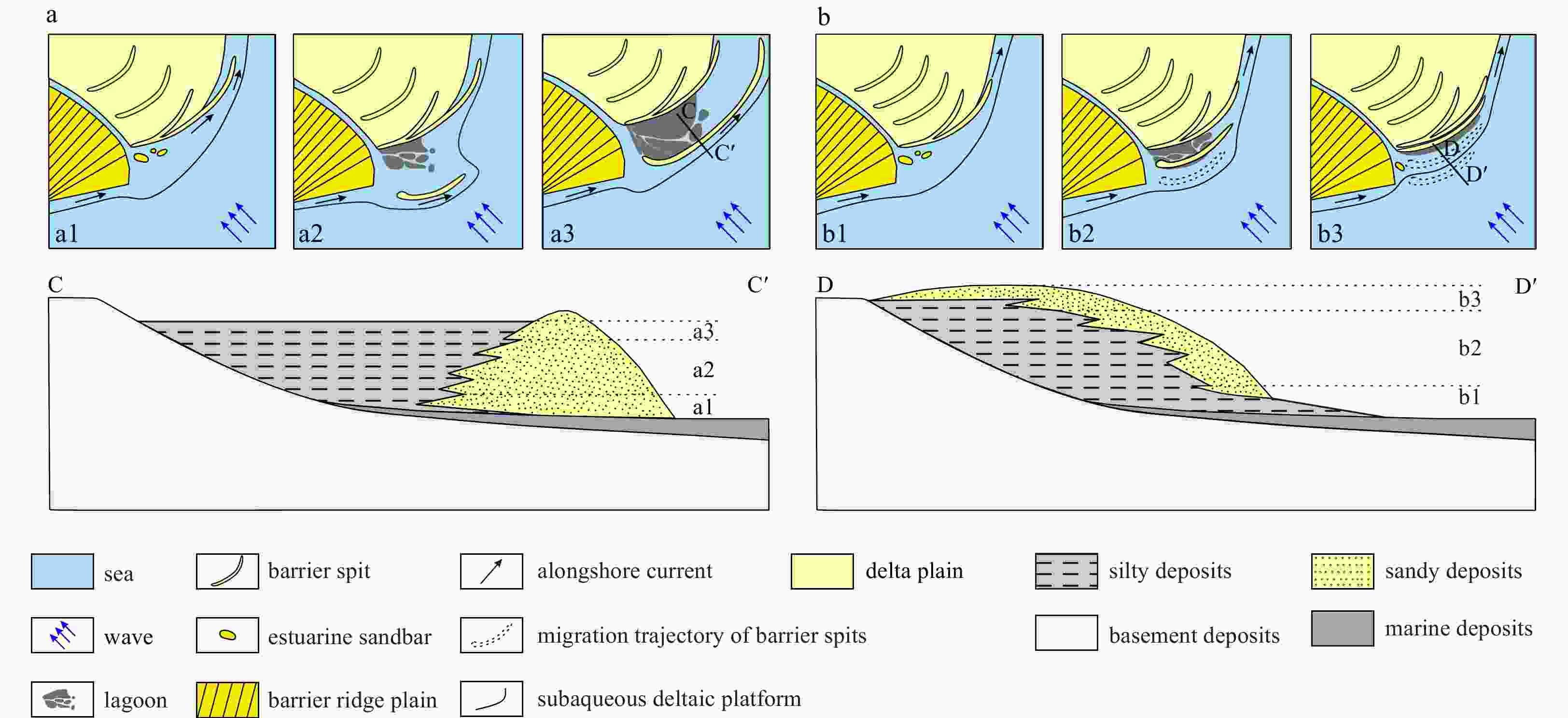Preliminary study on the depositional model in the wave-dominated delta evolution during the Anthropocene: a case study of the Hanjiang River Delta in China
-
Abstract: The deltas serve as the primary interactive zone where terrestrial and marine environments converge, playing a pivotal role in the coastal deposition. In the Holocene, climate changes and sea level fluctuation are the principal driving factors in the evolution of deltas. However, human activities such as the construction of dams and reservoirs in the Anthropocene have significantly altered sediment transport in rivers, leading to depositional pattern variation during deltaic evolution. In this study, we have conducted a comparative analysis of the morphological variations (1986–2021) in the barrier system of the Hanjiang River Delta (HRD) using satellite remote sensing (SRS) method. Additionally, we have examined the lithological changes and facies alterations observed in eight boreholes on the present barrier spit. Our findings indicate that the intensification of anthropogenic activities led to a significant reduction in the sediment flux of the Hanjiang River (HR), resulting in depocenter landward migration at the estuary. SRS analysis reveals their periodical morphological characteristics and spatial variations of estuarine sandbars (1986–1992), barrier islands-lagoons (1993–2009), and barrier spits (2010–2021) during 1986 to 2021. The stratigraphy of boreholes demonstrates a south-to-north facies transition from lagoon to lagoon-barrier spit and barrier spit in vertical lithology. Therefore, the depositional evolution of the HRD barrier system is categorized into three phases: estuarine sandbar-barrier island phase (1986–1998); barrier island-lagoon phase (1999–2009); and barrier spit phase (2010–2021). During the estuarine sandbar-barrier island phase, fluvial processes played a predominate role in the deposition. Consequently, with a significant decrease in river sediment load, the dominant factors driving depositional processes shifted towards wave action and alongshore current. Based on the conceptual model in the Holocene, we propose a modified depositional model of wave-dominated deltas during Anthropocene that encompasses three evolutionary phases: estuarine sandbars and delta front platforms, barrier island-lagoon formation and landward migration of barrier spits. This pattern highlights that human-induced reduction in river sediment flux has led to a seaward deltaic progradation driven by barrier landward migration.
-
Key words:
- Hanjiang River Delta /
- barrier spit /
- human activities /
- wave-dominated delta /
- depositional model
-
Figure 1. Schematic map of the Hanjiang River Delta (HRD, a and b) and the borehole locations (LY1–LY8) on the barrier spit (c). The purple and yellow lines present the artificial coastlines in 1986 and 2021, and the blue and green lines present the natural coastlines in 1986 and 2021, respectively. HR: Hanjiang River; LYR: Lianyang River; WSR: Waisha River; YFXR: Yifengxi River.
Figure 2. The variations of the runoff and sediment load of Hanjiang River (HR) and their regression curves during 1958 to 2019 (data from Zhao (2019)). The red lines and black lines present regression curves of the runoff and sediment load of HR, respectively. P1: Phase 1 (1986–1998), P2: Phase 2 (1999–2009), and P3: Phase 3 (2010–2021). The short blue dashed lines with numerical values represent the average sediment load of the three phases.
Figure 5. Shoreline change revisit and their migration rates of the HRD barrier spit (1999 to 2019) (for location see Fig. 1c). a. Shoreline changes at 5-year intervals; b. the migration trajectories and average migration rates of different regions. A, B, and C represent the migration tracks of the northern, middle, and southern areas of the barrier spit.
Figure 6. Lithologic logs, Mz (Ф), and the standard deviation (S.D.) of the borehole sediments in the Hanjiang River Delta barrier spit and their sedimentary facies. The red dashed line denotes the boundary between barrier and lagoon facies. The years in red font indicate the latest transition time of the two sedimentary facies.
Figure 7. Evolution of the barrier system in the HRD (1986–2021) (for location see Fig. 1b). The red dots represent the borehole locations (for location see Fig. 1c). The labeled black arrow marks illustrate the occurrence of the dominate facies at that time. LY1–LY8 represent the borehole locations. P1: Phase 1 (1986–1998), P2: Phase 2 (1999–2009), and P3: Phase 3 (2010–2021).
Figure 8. The conceptual depositional model of wave-dominated deltas (a) (after Vespremeanu-Stroe and Preoteasa, 2015; Preoteasa et al., 2016) and modified depositional model in the Anthropocene in this study (b). Lines of C–C' and D–D' present the transverse sections of two models.
-
Anthony E J. 2015. Wave influence in the construction, shaping and destruction of river deltas: a review. Marine Geology, 361: 53–78, doi: 10.1016/j.margeo.2014.12.004 Bastos L, Bio A, Pinho J L S, et al. 2012. Dynamics of the Douro estuary sand spit before and after breakwater construction. Estuarine, Coastal and Shelf Science, 109: 53–69 Besset M, Anthony E J, Bouchette F. 2019. Multi-decadal variations in delta shorelines and their relationship to river sediment supply: an assessment and review. Earth-Science Reviews, 193: 199–219, doi: 10.1016/j.earscirev.2019.04.018 Besset M, Anthony E J, Brunier G, et al. 2016. Shoreline change of the Mekong River delta along the southern part of the South China Sea coast using satellite image analysis (1973–2014). Géomorphologie: Relief, Processus, Environment, 22(2): 137–146 Bhattacharya J P, Giosan L. 2003. Wave-influenced deltas: geomorphological implications for facies reconstruction. Sedimentology, 50(1): 187–210, doi: 10.1046/j.1365-3091.2003.00545.x Bi Naishuang, Wang Houjie, Yang Zuosheng. 2014. Recent changes in the erosion–accretion patterns of the active Huanghe (Yellow River) delta lobe caused by human activities. Continental Shelf Research, 90: 70–78, doi: 10.1016/j.csr.2014.02.014 Bianchi T S, Allison M A. 2009. Large-river delta-front estuaries as natural “recorders” of global environmental change. Proceedings of the National Academy of Sciences of the United States of America, 106(20): 8085–8092 Brondizio E S, Foufoula-Georgiou E, Szabo S, et al. 2016. Catalyzing action towards the sustainability of deltas. Current Opinion in Environmental Sustainability, 19: 182–194, doi: 10.1016/j.cosust.2016.05.001 Carvalho B C, Dalbosco A L P, Guerra J V. 2020. Shoreline position change and the relationship to annual and interannual meteo-oceanographic conditions in Southeastern Brazil. Estuarine, Coastal and Shelf Science, 235: 106582 Chen Dan, Li Xing, Saito Y, et al. 2020. Recent evolution of the Irrawaddy (Ayeyarwady) Delta and the impacts of anthropogenic activities: a review and remote sensing survey. Geomorphology, 365: 107231, doi: 10.1016/j.geomorph.2020.107231 Cheng Lin, Tian Hailan, Liu Xihan, et al. 2020. Variations and influencing factors of the barrier islands near the Luan River estuary in the past 44 years—A case study of the Loong Island in Tangshan. Marine Sciences (in Chinese), 44(6): 22–30 Chong A K. 2004. A case study on the establishment of shoreline position. Survey Review, 37(293): 542–551, doi: 10.1179/sre.2004.37.293.542 Dan S, Walstra D J R, Stive M J F, et al. 2011. Processes controlling the development of a river mouth spit. Marine Geology, 280(1−4): 116–129, doi: 10.1016/j.margeo.2010.12.005 Day J W, Pont D, Hensel P F, et al. 1995. Impacts of sea-level rise on deltas in the Gulf of Mexico and the Mediterranean: the importance of pulsing events to sustainability. Estuaries, 18(4): 636–647, doi: 10.2307/1352382 Dominguez J M L, Guimarães J K. 2021. Effects of Holocene climate changes and anthropogenic river regulation in the development of a wave-dominated delta: the São Francisco River (eastern Brazil). Marine Geology, 435: 106456, doi: 10.1016/j.margeo.2021.106456 Dunn F E, Darby S E, Nicholls R J, et al. 2019. Projections of declining fluvial sediment delivery to major deltas worldwide in response to climate change and anthropogenic stress. Environmental Research Letters, 14(8): 084034, doi: 10.1088/1748-9326/ab304e Eric C, Florian O, Xavier B, et al. 2014. Control of wave climate and meander dynamics on spit breaching and inlet migration. Journal of Coastal Research, 70(sp1): 109–114 Ericson J P, Vörösmarty C J, Dingman S L, et al. 2006. Effective sea-level rise and deltas: causes of change and human dimension implications. Global and Planetary Change, 50(1/2): 63–82, doi: 10.1016/j.gloplacha.2005.07.004 Fanos A M. 1995. The impact of human activities on the erosion and accretion of the Nile Delta coast. Journal of Coastal Research, 11(3): 821–833 Frihy O E, Debes E A, El Sayed W R. 2003. Processes reshaping the Nile delta promontories of Egypt: pre- and post-protection. Geomorphology, 53(3/4): 263–279, doi: 10.1016/S0169-555X(02)00318-5 Galloway W E. 1975. Process framework for describing the morphologic and stratigraphic evolution of deltaic depositional systems. Houston: Houston Geological Society, 87–98 Kaergaard K, Fredsoe J. 2013. Numerical modeling of shoreline undulations part 2: varying wave climate and comparison with observations. Coastal Engineering, 75: 77–90, doi: 10.1016/j.coastaleng.2012.11.003 Li Chunchu. 1986a. Geomorphic characteristics of the harbor-coasts in South China. Acta Geographica Sinica (in Chinese), 41(4): 311–320 Li Pingri. 1986b. The shoreline evolution in the Hanjiang River Delta during the past 6000 years. Chinese Science Bulletin (in Chinese), 31(19): 1495–1499, doi: 10.1360/csb1986-31-19-1495 Li Pingri. 1987. The shoreline evolution and the development model of the Hanjiang River Delta during the past 6000 years. Geographical Research (in Chinese), 6(2): 1–13 Li Pingri, Huang Zhenguo, Zhang Zhongying, et al. 1987. Changes of sea level since Late Pleistocene in eastern Guangdong. Haiyang Xuebao (in Chinese), 9(2): 216–222 Li Pingri, Huang Zhenguo, Zong Yongqiang. 1988. New views on geomorphological development of the Hanjiang River Delta. Acta Geographica Sinica (in Chinese), 43(1): 19–34 Li Xing, Liu J P, Saito Y, et al. 2017. Recent evolution of the Mekong Delta and the impacts of dams. Earth-Science Reviews, 175: 1–17, doi: 10.1016/j.earscirev.2017.10.008 Li Xiaolu, Yu Xinghe, Tan Chengpeng, et al. 2015. Sedimentary evolution and sand-body distribution of Holocene period, barrier-coast delta, Chaoshan region. Acta Sedimentologica Sinica (in Chinese), 33(4): 706–712 Lin Miaoqing, Du Qinbo, Weng Wukun. 2010. Characteristics of strong wind in the past 40 years in Nan’ao county, Guangdong province. Journal of Meteorology and Environment (in Chinese), 26(4): 48–52 McManus J. 2002. Deltaic responses to changes in river regimes. Marine Chemistry, 79(3/4): 155–170, doi: 10.1016/S0304-4203(02)00061-0 Milliman J D, Broadus J M, Gable F. 1989. Environmental and economic implications of rising sea level and subsiding deltas: the Nile and Bengal examples. Ambio, 18(6): 340–345 Milliman J D, Farnsworth K L. 2011. River Discharge to the Coastal Ocean: A Global Synthesis. Cambridge: Cambridge University Press, 392 Munasinghe D, Cohen S, Gadiraju K. 2021. A review of satellite remote sensing techniques of river delta morphology change. Remote Sensing in Earth Systems Sciences, 4(1/2): 44–75, doi: 10.1007/s41976-021-00044-3 Nicholls R J, Adger W N, Hutton C W, et al. 2020. Deltas in the Anthropocene. Cham, Switzerland: Palgrave Macmillan Cham, 1–22 Oertel G F. 1985. The barrier island system. Marine Geology, 63(1−4): 1–18, doi: 10.1016/0025-3227(85)90077-5 Orford J D, Carter R W G, Jennings S C. 1996. Control domains and morphological phases in gravel-dominated coastal barriers of Nova Scotia. Journal of Coastal Research, 12(3): 589–604 Panin N, Jipa D. 2002. Danube River sediment input and its interaction with the north-western Black Sea. Estuarine, Coastal and Shelf Science, 54(3): 551–562 Petersen D, Deigaard R, Fredsøe J. 2008. Modelling the morphology of sandy spits. Coastal Engineering, 55(7/8): 671–684., doi: 10.1016/j.coastaleng.2007.11.009 Postma G. 1990. An analysis of the variation in delta architecture. Terra Nova, 2(2): 124–130, doi: 10.1111/j.1365-3121.1990.tb00052.x Preoteasa L, Vespremeanu-Stroe A, Tătui F, et al. 2016. The evolution of an asymmetric deltaic lobe (Sf. Gheorghe, Danube) in association with cyclic development of the river-mouth bar: long-term pattern and present adaptations to human-induced sediment depletion. Geomorphology, 253: 59–73, doi: 10.1016/j.geomorph.2015.09.023 Qi Yali, Yu Qian, Gao Shu, et al. 2021. Morphological evolution of river mouth spits: wave effects and self-organization patterns. Estuarine, Coastal and Shelf Science, 262: 107567 Renaud F G, Syvitski J P M, Sebesvari Z, et al. 2013. Tipping from the Holocene to the Anthropocene: how threatened are major world deltas?. Current Opinion in Environmental Sustainability, 5(6): 644–654 Riggs S R, Cleary W J, Snyder S W. 1995. Influence of inherited geologic framework on barrier shoreface morphology and dynamics. Marine Geology, 126(1−4): 213–234, doi: 10.1016/0025-3227(95)00079-E Simeoni U, Fontolan G, Tessari U, et al. 2007. Domains of spit evolution in the Goro area, Po Delta, Italy. Geomorphology, 86(3/4): 332–348 Stutz M L, Pilkey O H. 2001. A review of global barrier island distribution. Journal of Coastal Research, (34): 15–22 Stutz M L, Pilkey O H. 2002. Global distribution and morphology of deltaic barrier island systems. Journal of Coastal Research, 36(sp1): 694–707 Syvitski J P M. 2008. Deltas at risk. Sustainability Science, 3(1): 23–32, doi: 10.1007/s11625-008-0043-3 Syvitski J P M, Kettner A J, Overeem I, et al. 2009. Sinking deltas due to human activities. Nature Geoscience, 2(10): 681–686, doi: 10.1038/ngeo629 Syvitski J P M, Vorosmarty C J, Kettner A J, et al. 2005. Impact of humans on the flux of terrestrial sediment to the global coastal ocean. Science, 308(5720): 376–380, doi: 10.1126/science.1109454 Szabo S, Brondizio E, Renaud F G, et al. 2016. Population dynamics, delta vulnerability and environmental change: comparison of the Mekong, Ganges–Brahmaputra and Amazon delta regions. Sustainability Science, 11(4): 539–554, doi: 10.1007/s11625-016-0372-6 Ta T K O, Nguyen V L, Tateishi M, et al. 2002a. Sediment facies and Late Holocene progradation of the Mekong River Delta in Bentre Province, southern Vietnam: an example of evolution from a tide-dominated to a tide- and wave-dominated delta. Sedimentary Geology, 152(3/4): 313–325, doi: 10.1016/S0037-0738(02)00098-2 Ta T K O, Nguyen V L, Tateishi M, et al. 2002b. Holocene delta evolution and sediment discharge of the Mekong River, southern Vietnam. Quaternary Science Reviews, 21(16/17): 1807–1819, doi: 10.1016/S0277-3791(02)00007-0 Tamura T, Saito Y, Nguyen V L, et al. 2012. Origin and evolution of interdistributary delta plains; insights from Mekong River delta. Geology, 40(4): 303–306, doi: 10.1130/G32717.1 Tsyban A V, Everett J T, Titus J G. 1990. World oceans and coastal zones. In: Tegart W, Sheldon G W, Griffiths D C, eds. Climate Change: the IPCC Impacts Assessment. Canberra, Australia: Australian Government Publishing Service, 1–28 van Maren D S. 2005. Barrier formation on an actively prograding delta system: the Red River Delta, Vietnam. Marine Geology, 224(1−4): 123–143, doi: 10.1016/j.margeo.2005.07.008 van Maren D S, Hoekstra P. 2003. Cyclic development of a wave dominated delta. In: Proceedings of Coastal Sediments’03. Corpus Christi: East Meets West Productions, 12 Vespremeanu-Stroe A, Preoteasa L. 2015. Morphology and the cyclic evolution of Danube delta spits. In: Randazzo G, Jackson D W T, Cooper J A G, eds. Sand and Gravel Spits. Cham, Switzerland: Springer, 327–339 Walling D E, Fang D. 2003. Recent trends in the suspended sediment loads of the world’s rivers. Global and Planetary Change, 39(1/2): 111–126, doi: 10.1016/S0921-8181(03)00020-1 Wang Muwang. 2017. Tidal level change of coastal of Hanjiang River Delta. Guangdong Water Resources and Hydropower (in Chinese), (11): 1–4 Wang Kuifeng. 2019. Evolution of Yellow River Delta coastline based on remote sensing from 1976 to 2014, China. Chinese Geographical Science, 29(2): 181–191, doi: 10.1007/s11769-019-1023-5 Woodroffe C D, Nicholls R J, Saito Y, et al. 2006. Landscape variability and the response of Asian megadeltas to environmental change. In: Harvey N, ed. Global Change and Integrated Coastal Management: The Asia-Pacific Region. Dordrecht: Springer, 277–314 Wu Sangyun, Geng Xiushan, Jin Yongde, et al. 2008. Evolution of lagoon system in the Jidong area and effect of human interference. Advances in Marine Science (in Chinese), 26(2): 190–199 Yang Chuanxun, Zhang Zhengdong, Zhang Qian, et al. 2017. Characteristics of multi-scale variability of water discharge and sediment load in the Hanjiang River during 1955–2012. Journal of South China Normal University (Natural Science Edition) (in Chinese), 49(3): 68–75 Zalasiewicz J, Waters C, Head M J. 2017. Anthropocene: its stratigraphic basis. Nature, 541(7637): 289–289 Zeng Qiang, Shao Rongsong. 2002. Geological environment and hazardous geological issues in the Hanjiang River Delta. The Chinese Journal of Geological Hazard and Control (in Chinese), 13(4): 91–93 Zhang Hunan. 1983. Tectonic activity and its impact on the formation and development of the Hanjiang River Delta. Haiyang Xuebao (in Chinese), 5(2): 202–211 Zhang Yupo. 2016. Analysis of sediment changes at the Chao’an Station on the main stream of the Han River. Science and Technology & Innovation (in Chinese), (15): 78–80 Zhang Xiaodong, Lu Zhiyong, Jiang Shenghui, et al. 2018a. The progradation and retrogradation of two newborn Huanghe (Yellow River) Delta lobes and its influencing factors. Marine Geology, 400: 38–48, doi: 10.1016/j.margeo.2018.03.006 Zhang Xiaodong, Wu Chuang, Zhang Yongchang, et al. 2022. Using free satellite imagery to study the long-term evolution of intertidal bar systems. Coastal Engineering, 174: 104123, doi: 10.1016/j.coastaleng.2022.104123 Zhang Xiaodong, Yang Zuosheng, Zhang Yexin, et al. 2018b. Spatial and temporal shoreline changes of the southern Yellow River (Huanghe) Delta in 1976–2016. Marine Geology, 395: 188–197, doi: 10.1016/j.margeo.2017.10.006 Zhao Lan. 2019. Characteristic Analysis of runoff and sediment at Chao’an Hydrometric Station in Hanjiang River Basin. Guangdong Water Resources and Hydropower (in Chinese), (1): 22–25 Zhao Bin, Guo Haiqiang, Yan Yaner, et al. 2008. A simple waterline approach for tidelands using multi-temporal satellite images: a case study in the Yangtze Delta. Estuarine, Coastal and Shelf Science, 77(1): 134–142 Zhu Junfeng, Wang Gengming, Zhang Jinlan, et al. 2013. Remote sensing investigation and recent evolution analysis of Pearl River delta coastline. Remote Sensing for Land and Resources (in Chinese), 25(3): 130–137 Zhu Xiaoyu, Zhang Yanpeng. 2023. The change analyses of shoreline in Jiangdong new distract and its adjacent region, Haikou. South China Geology (in Chinese), 39(1): 127–137 Zong Yongqiang. 1987. Developmental characteristics of the Han River Delta Landform. Chinese Science Bulletin (in Chinese), 32(22): 1734–1737, doi: 10.1360/csb1987-32-22-1734 -





 下载:
下载:
